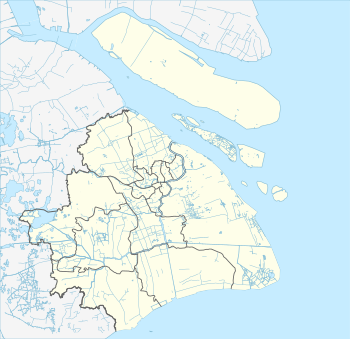Zhenru Temple (Shanghai)
Zhenru Temple (Chinese: 真如寺; pinyin: Zhēnrú Sì) is a Buddhist temple located in Putuo District of Shanghai, China.[1] It is a Major National Historical and Cultural Site in Shanghai.
| Zhenru Temple | |
|---|---|
真如寺 | |
 Zhenru Temple. | |
| Religion | |
| Affiliation | Buddhism |
| Deity | Chan Buddhism |
| Leadership | Miaoling (妙灵) |
| Location | |
| Location | Putuo District, Shanghai |
| Country | China |
 Shown within Shanghai  Zhenru Temple (Shanghai) (China) | |
| Geographic coordinates | 31°15′20″N 121°24′29″E |
| Architecture | |
| Style | Chinese architecture |
| Date established | Song dynasty (960–1276) |
| Completed | 1320 (reconstruction) |
Name
The name "Zhenru" (真如) means "thusness" or "reality as it is" in Chinese, and comes from the Buddhist sutra Vijnaptimatratasiddhi-sastra or Cheng Wei-Shih Lun (成唯识论) in Chinese.
History
Song dynasty
In its first iteration, built in the Song dynasty (960–1276) it was called "Zhenru Yuan" (真如院) originally, and changed to "Zhenru Si" (真如寺) by monk Yong'an (永安) in the Jiading era (1208–1224) of the Southern Song dynasty (1127–1276).
Yuan dynasty
In 1320, during the reign of Ayurbarwada Buyantu Khan in the Mongolian ruling Yuan dynasty (1271–1368), monk Miaoxin (妙心) moved the temple to the present site.
Ming dynasty
Zhenru Temple has been repaired two times in the Ming dynasty (1368–1644), one in the Hongwu period (1368–1398) and the other in the Hongzhi period (1488–1505).
Qing dynasty
In 1860, in the reign of Xianfeng Emperor (1851–1861) of the Qing dynasty (1644–1911), the temple was devastated by the Taiping Rebellion.
People's Republic of China
In May 1959, it was authorized as a municipal cultural heritage building.
In 1966, Mao Zedong launched the Cultural Revolution. Statues and other works of art were either removed, damaged or destroyed by the Red Guards, including a Ming dynasty gilded copper statue of Maitreya and a Qing dynasty carved wood statue of Sakyamuni.
In 1979, the Shanghai Municipal Government refurbished and redecorated the temple, and used it as an ancient architecture exhibition hall.
In 1991, regular scripture lectures, meditation and other features of temple life were resumed.
In January 1992, Singaporean Buddhist monk Xingren (性仁) presented three jade statues of the Buddha and some Buddhist sutras to the temple.
On November 20, 1996, it has been designated as a "Major National Historical and Cultural Site in Shanghai" by the State Council of China.[2]
Architecture
The existing main buildings include the Shanmen, Four Heavenly Kings Hall, Mahavira Hall and Guanyin Hall.
Mahavira Hall
The Mahavira Hall was built in 1320 during the Yuan dynasty (1271–1368). The hall is 13.4-metre (44 ft) wide and 13-metre (43 ft) deep with 16 wood pillars supporting the single eave gable and hip roof (单檐歇山顶). A 2.18-metre (7 ft 2 in) high and 2,500-kilogram (5,500 lb) jade statue of Sakyamuni sits in the center of the hall.[2]
References
- 真如寺周围将建保护区. 163.com (in Chinese). 2015-11-19.
- Yao Jing (2010). 江南罕见的元代木结构建筑 全国重点文物保护单位真如寺大殿简介. eastday.com (in Chinese).